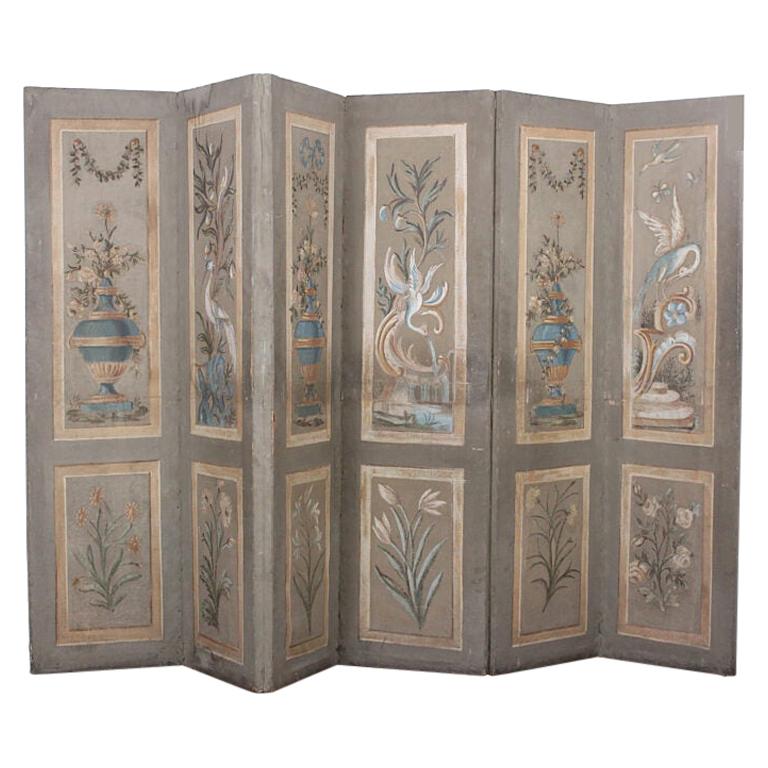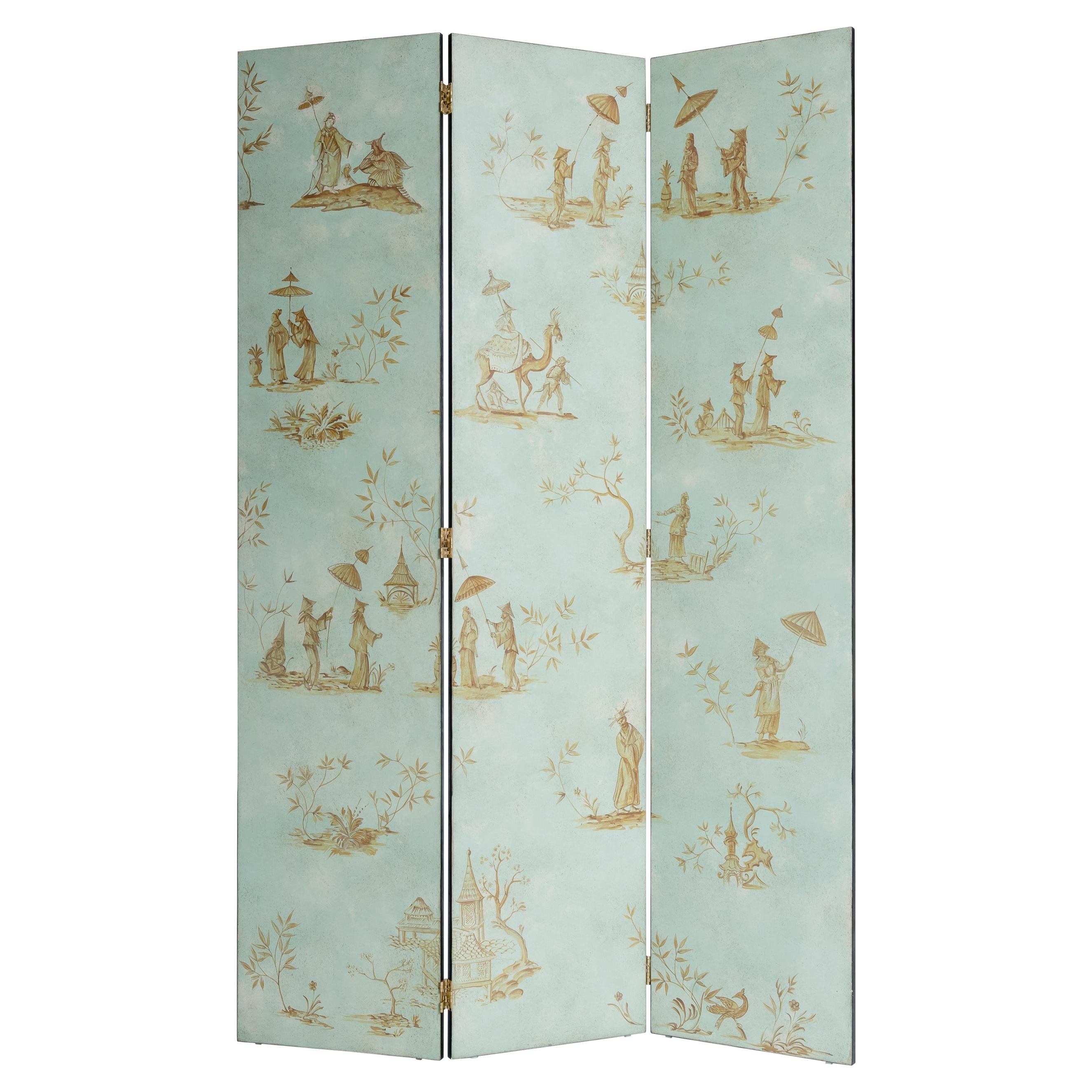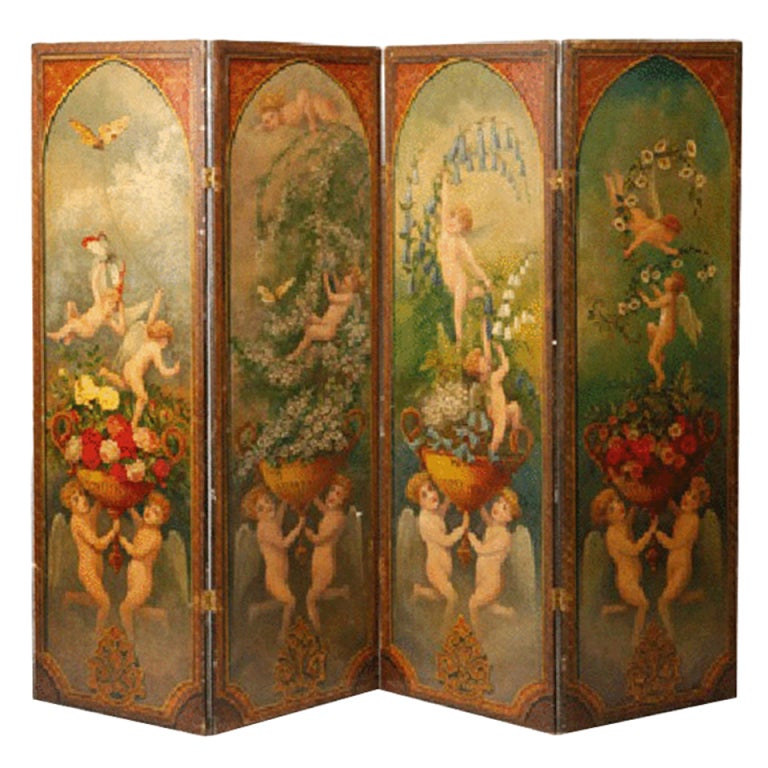Items Similar to 19th Century Italian Six-Panel Painted Wood Folding Screen in Gilt Bronze Frame
Video Loading
Want more images or videos?
Request additional images or videos from the seller
1 of 17
19th Century Italian Six-Panel Painted Wood Folding Screen in Gilt Bronze Frame
About the Item
This one-of-a-kind museum quality Italian Empire Period (early 19th Century) room divider folding screen is made up of six rectangular solid wood panels, each richly painted and lacquered with a nice trompe l'oeil effect and housed in gilt bronze frames.
Architectural motifs, vases, music and art allegories, flowers, putti, grotesque and symbolic animals inspired by the Ancient Greek and Ancient Roman Gods are the main patterns that decorate this wonderful art object.
The warm white background with a gorgeous craquelè is masterfully hand painted with exceptional polychromed decorations most of them inspired by Renaissance period.
Porphyry red, petrol blue, different shades of pink, brown, green and gold alternate in the lacquered paints on the wood.
Its classical beauty and colors will work great with any color scheme interior design projects whether you decide to use it as a free standing decorative piece room divider or a wall decoration's artwork.
Each of the four central panels depict an allegory of a Roman or ancient Greece mythological God: The Swan, because of its beauty, symbolizes Venus; the Peacock, considered a sacred bird to Juno the Queen of all Gods symbolizes the immortality; the Eagle, symbol of power and victory, is the attribute and messenger of Jupiter or Zeus. Athena, Goddess of Wisdom, Learning, Arts, Sciences, Medicine, Trade, and of War, is represented by the Owl that symbolizes the night.
Each panel is flanked by a finely hand chiseled gilt bronze frame with acanthus leaves motifs. The ormolu frame is a masterpiece itself.
The back is entirely covered with the original antique light green silk fabric featuring neoclassical scenes patterns. The silk is in very good condition back the central four panels, frayed fabric in the two external panels.
Wonderful empire period patterns that will make this precious screen a focal point in any interior project. The decorations inspired by ancient Rome and ancient Greece are a common decorative elements on Empire and Neoclassical period as an appropriate iconography for the themes of power and victory prevalent during the Napoleonic wars of the early 19th century. The style called ‘Empire’ in Italy and France, corresponds to ‘Regency’ in England, Biedermeier in the German-speaking lands and the American ‘Federal’.
This elegant and precious screen was probably part of a magnificent paneled room with boiserie, than framed and turned into a folding paravan. It has an important provenance,
it was part of the furnishings of a neoclassical villa in Lucca, Tuscany, whose ceilings were painted with frescoes featuring the same decorative motifs as the screen.
This rare piece of furniture is ready to embellish your home, a conversation antique item rich in history and craftsmanship.
It can be placed on the floor as a room divider, near a sofa or to fill a space between two doors. Great statement piece of art totally unfold and hung on the wall.
This important and completely intact folding screen can be dated to that particular segment of the Italian Empire called Lucchese (named after the city of Lucca) lasted from 1801 to 1805. It is a rare example of Tuscan Empire and Lucchese neoclassical furniture, made during the Republic of Lucca, a renowned city near Florence, established by Napoleon Bonaparte on Dec. 27, 1801, after his second successful conquest of Italy, driving out the Austrians. The Republic lasted less than four years; in June 1805 Napoleon granted Lucca to his sister Elisa Bonaparte as a principality, part of the new French Empire.
Measures: height 150 cm (59.1 in), Width 102 cm (40.2 in)
Shipping complimentary.
- Dimensions:Height: 62.21 in (158 cm)Width: 77.96 in (198 cm)Depth: 1.19 in (3 cm)
- Style:Empire (Of the Period)
- Materials and Techniques:
- Place of Origin:
- Period:
- Date of Manufacture:1801-1805
- Condition:Wear consistent with age and use.
- Seller Location:Firenze, IT
- Reference Number:
About the Seller
5.0
Vetted Seller
These experienced sellers undergo a comprehensive evaluation by our team of in-house experts.
Established in 1950
1stDibs seller since 2012
109 sales on 1stDibs
Typical response time: 2 hours
- ShippingRetrieving quote...Ships From: Firenze, Italy
- Return PolicyThis item cannot be returned.
More From This SellerView All
- Italian Neoclassical Architectural Etched Engravings Six Panels Folding ScreenBy Giovanni OttavianiLocated in Firenze, ITThis Italian 18th century Neoclassical period folding screen consists of six panels with antiques etched and engraved copperplates on paper reproducing the frecoes painted by Raffaello Sanzio in the Vatican, known as ' The Vatican Loggia'. Each engraving - boasting a fantastic variety of black and grayscales - is applied to paper and set in frame flanked by a sage green fabric. At the bottom each panel is finished with an ink painted cartouche, completing the screen like a faux paneled boiserie...Category
Antique 18th Century Italian Neoclassical Screens and Room Dividers
MaterialsTextile, Cotton, Paper
- French Early 20th Century Tempera on Canvas Folding Screen with Seascape ViewLocated in Firenze, ITThis French early 20th Century folding screen is made up of four canvases entirely painted with textured tempera featuring a marine l...Category
Early 20th Century French Screens and Room Dividers
MaterialsMetal
- French 19th Century Empire Porcelain and Gilt Bronze Decorative Jewelry BoxLocated in Firenze, ITThis French Empire 19th century rectangular porcelain dresser box or jewlery decorative casket has a wonderfully patinated powder blue/cerulean light blue background color and features grotesque masks, architectural vase, fruit, flowers and leafy scrolled design throughout painted as a trompe l’oeil in the round. Ormolu mounts enrich the whole box. The paintings on this casket are striking as is the color palette used, a wonderful mix of light purple, cream, blue and soft brown. The lid is centered by a grotesque mask inspired by antiquity. The front, back and sides are profusely decorated with architectural elements, cartouches and volutes. The design is centered by a vase with a fruit arrangement that appear to be plums. The decoration could refer to the allegory of autumn and the mask painted on the lid could refer to Bacchus. Both the color of the porcelain and the paintings are very unusual and a sign of high quality and uniqueness.The box was most probably given to a high-ranking lady as a gift on the occasion of her marriage, or perhaps after the birth of a child. The lidded box is fitted with ormolu mounts, hinges and clasp. A gilt bronze band finelly chiseled in the form of a rope adorns the upper part. The trinket box rests on four gilt bronze lion paw feet. This striking French porcelain box...Category
Antique 19th Century French Empire Jewelry Boxes
MaterialsBronze, Ormolu
- Italian 19th Century Gilt Bronze and Enameld Neo Gothic 12 Lighs ChandelierLocated in Firenze, ITThis antique 19th century Italian large gilt bronze and enameld Neo Gothic pendant chandelier dating back to 1850 circa is a stunning handcra...Category
Antique 19th Century Italian Gothic Revival Chandeliers and Pendants
MaterialsBronze, Enamel
- Italian 19th Century Renaissance Style Wood Lacquer and Painted Gesso Lidded BoxLocated in Firenze, ITThis beautiful 19th century Florentine rectangular lidded box is entirely decorated in the round with all typical Renaissance Italian patterns. The whi...Category
Antique 19th Century Italian Renaissance Jewelry Boxes
MaterialsGesso, Plaster, Wood
- Italian 20th Century Faux Red Porphyry Lacquered and Gilt Framed Wood DoorsLocated in Firenze, ITThis very unusual 20th century Italian pair of two wood doors come from a Florentine house. The front of each rectangular door panel is lacquered as brick red faux porphyry marble, v...Category
20th Century Italian Neoclassical Doors and Gates
MaterialsBrass, Iron
You May Also Like
- Early 19th Century Six-Panel ScreenLocated in Vancouver, British ColumbiaEarly 19th century French six-panel painted screen. Beautifully hand painted.Category
Antique Early 19th Century Screens and Room Dividers
MaterialsCanvas, Wood
- 18th Century Hand-Painted Venetian Style Aquamarine 3-Panels Otello ScreenBy Porte ItaliaLocated in Ronchi dei Legionari, ITFrom our Hand-Painted Furniture Collection, we are pleased to introduce you to our aquamarine otello screen with ochre chinoiserie vignettes. A hand-painted screen evokes the luxury...Category
2010s Italian Other Screens and Room Dividers
MaterialsWood
- Mid-18th Century Spanish Set of Two 4-Panel Embossed Leather Folding ScreensLocated in Marbella, ESMid-18th century Spanish set of two 4-panel oak embossed leather folding screens in Cordoba manner with gilt, colorful polychromy, bone and "pal...Category
Antique 18th Century Screens and Room Dividers
MaterialsLeather, Wood
- 1950s Spanish Folding Screen / Room Divider in Gilt MetalLocated in Barcelona, ESFaux bamboo foliage folding screen, wrought iron, gold leaf, Spain, 1960s Eye-catching gilt metal three-panel folding screen or room divider with faux bamboo ironstructure and foliag...Category
20th Century Spanish Mid-Century Modern Screens and Room Dividers
MaterialsMetal, Iron, Gold Leaf
- Antique French folding screen painted in the Romantic styleLocated in London, GBDecorated with figures of winged cherubs amongst vases of flowers and other similar subjects, the reverse painted with landscape scenes. This beautiful antique French folding screen...Category
Antique 19th Century French Romantic Screens and Room Dividers
MaterialsWood
- 20th Century French Two Panel ScreenLocated in Nashville, TNTwo panel folding screen with oil paintings depicting mythological male figures. Back of screen is upholstered in silk damask. Brass nailhead trim. Fabric hinges.Category
Early 20th Century French Screens and Room Dividers
MaterialsSilk, Damask
Recently Viewed
View AllMore Ways To Browse
Neoclassic Furniture
Antique Blue Living Room
Wood Paneled Room
Wood Panel Room
Painted Room Panel
Wood Folding
Antique Pink Room
Hand Painted Wood Panel
Decorating Antique Homes
19th Century Painted Wood Panel
Antique Room Divider
Room Divider Antique
Antique Room Divider Furniture
White And Gilt Wood
Antique Wood Panel Painted
Antique Home Interior Design
Hand Painted Flowers On Wood
Antique White Paint For Wood





